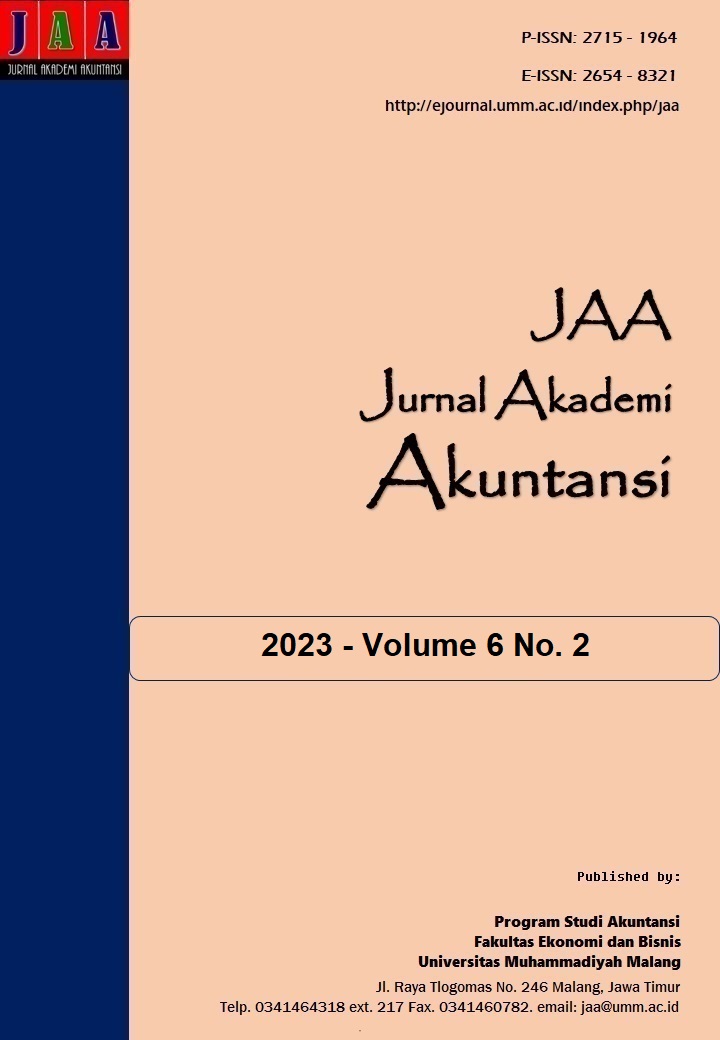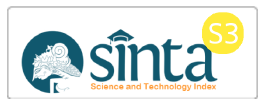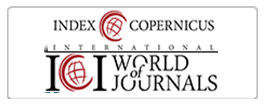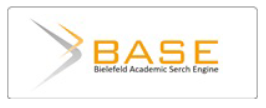Studi Etnometodologi: Peengendalian Persediaan Beras Bulog
DOI:
https://doi.org/10.22219/jaa.v6i2.26141Keywords:
Control, Inflow, Inventory, Outflow, Perum Bulog Regional Office NTBAbstract
Purpose: This research aims to interpret rice inventory control by Perum Bulog Regional Office of NTB
Methodology/approach: This research uses a qualitative approach with ethnomethodology method. Data collection techniques used observation and interviews. The informants in this study amounted to 4 people consisting of 2 warehouse weighers, 1 OPP implementation staff, and 1 quality management.
Findings: The results of this study indicate that the control of rice inventory by Perum Bulog Regional Office of NTB consists of, entry flow, exit flow, and storage of rice quality maintenance in the warehouse. The flow of rice is carried out according to the order from the office in the form of SO (Sell Order) Form through the distribution of disaster relief rice reserves, distribution of class groups, movement activities, and distribution of supply availability and price stability (KPSH). In addition, the flow of rice in the Bulog Regional Office of NTB is carried out in accordance with orders from the office in the form of PO (Purchase Order) Forms through work units (Satker), partnership programs, and through grain and rice processing units (UP-GB). Control of rice inventory at Perum Bulog Regional Office of NTB is carried out in accordance with logistics orders to maintain inventory turnover at the price of government regulations.
Practical and Theoretical contribution/Originality: Controlling rice inventory at Perum Bulog Regional Office of NTB using Ethnomethodology methods
Research Limitation: It is difficult to arrange informants' schedules to conduct interviews due to many other jobs so that researchers have difficulty when obtaining data
Downloads
References
Anggraini, D., Nurhayati, Y., & Agusman, M. R. (2020). Analisis Sistem Pengendalian Intern Atas Persediaan Beras Pada Perum Bulog Kansilog Lubulinggau. Jurnal Akun Stie (JAS), 6(1), 62-75. https://doi.org/ 10.32767/JAS.V6I1.942
Ardiansah, I. (2017). Analisis perencanaan dan pengendalian persediaan beras pada Perum BULOG Divisi Regional Jawa Barat. STRING (Satuan Tulisan Riset dan Inovasi Teknologi), 2(1), 10-17. http://dx.doi.org/10.30998/string.v2i1.1118
Azzahra, H. (2022). Analisis persediaan beras pada Perum Bulog Kanwil Sumatera Selatan dan Bangka Belitung tahun 2016-2020. Fakultas Pertanian Universitas Sriwijaya.
Candraningtyas, P., Jati, W. S., Fadhlullah, Fauzan, I. F., & Suhesti, N. T. (2021). Konsumsi bahan pokok 2019. Badan Pusat Statistik.
Claudiana, V. R. (2021). Analisis Pengendalian atas Persediaan Beras pada Perum Bulog Kantor Cabang Surabaya Utara (Doctoral dissertation, Universita Hayam Wuruk Perbanas Surabaya).
Djalamang, Z. J., Qosim, N., & Hasan, H. (2021). Analisis Persediaan Beras Pada Toko Bali Yasa Luwuk Banggai. Jurnal Ekonomi Trend, 9(1), 35-47. https://doi.org/10.31970/trend.v9i1.205
Fauzi, A., Zakia, A., Putra, B. A., Bagaskoro, D. S., Pangestu, R. N., & Wijaya, S. (2022). Faktor-Faktor Yang Mempengaruhi Dampak Persediaan Barang Dalam Proses Terhadap Pehitungan Biaya Proses: Persediaan Barang Perusahaan, Kalkulasi Biaya Pesanan Dan Pemakaian Bahan Baku (Literature Review Akuntansi Manajemen). Jurnal Ilmu Hukum, Humaniora Dan Politik, 2(3), 253-266. https://doi.org/10.38035/jihhp.v2i3
Febryanti, L., Soedarto, T., & Amir, I. T. (2023). Analisis Pengadaan dan Pengendalian Persediaan Beras pada Bulog Kantor Cabang Kediri. Jurnal Pertanian Agros, 25(1), 960-965.
Herlambang, A. I. P., & Dewi, R. (2017). Pengendalian Persediaan Bahan Baku Beras Dengan Metode Economic Order Quantity (EOQ) Multi Produk Guna Meminimumkan Biaya. Ekonomi & Bisnis, 2, 525–542.
Kamayanti, A. (2016). Metode penelitian kualitatif akuntansi (Aji Dedi Mulawarman, Ed.). CV Peneleh, Pondok Indah Estatte Blok B.
Kristyaningrum, E. Y., Ekowati, T., & Setiyadi, A. (2018). Efisiensi Persediaan Beras Pada Perusahaan Umum Bulog Divisi Regional Jawa Timur. Agro Ekonomi, 27(1), 38-51. https://doi.org/10.22146/jae.32793
Mamoriska, S. (2020). Reposisi BULOG dalam Rencana Pembentukan Badan Pangan Nasional (Repositioning of BULOG in The Formation Plan of National Food Agency). JURNAL PANGAN, 29(3), 221-242. https://doi.org/10.33964/jp.v29i3.528
Mariani, A., Ibnas, R., & Wulandani, R. E. (2022). Analisis Pengendalian Persediaan Beras Menggunakan Metode Economic Order Quantity Pada Perum Bulog Subdivre Sidrap. Jurnal MSA (Matematika dan Statistika serta Aplikasinya), 10(2), 95-103.
Prakoso, P. B., Haryadi, B., & Lisa, O. (2022). Mengungkap Potensi Fraud Dan Upaya Pencegahannya Di Perusahaan X. Jurnal Akademi Akuntansi, 5(3), 364–375. https://doi.org/10.22219/jaa.v5i3.21101
Pratiwi, F. (2021, November 18). Puluhan Ribu Ton Beras BULOG NTB Dikirim ke Tiga Provinsi. Https://News.Republika.Co.Id. https://news.republika.co.id/berita//r2rh71457/bulog-ntb-kirim-25-200-ton-beras-ke-tiga-provinsi?
Rizaty, M. A. (2022, November). BPS: Jumlah Penduduk Indonesia. Badan Pusat Statistik. https://dataindonesia.id/varia/detail/bps-jumlah-penduduk-indonesia-sebanyak-27577-juta-pada-2022
Sakia, N. (2021). Analisis Pengadaan Dan Pengendalian Persedian Beras Bulog (Studi Kasus Di Gudang Lapadde Perum Bulog Subdivre Parepare) (Doctoral dissertation, UNIVERSITAS HASANUDDIN).
Tangkudung, A. J., Halid, A., & Saleh, Y. (2016). analisis penerapan manajemen dan strategi distribusi beras di perusahaan umum badan urusan logistik (perum bulog sub divre kota gorontalo). AGRINESIA: Jurnal Ilmiah Agribisnis, (1). https://doi.org/10.37046/agr.v0i1.1402
Ternando, G., Susena, K. C., & Herlin. (2018). Analisis Pengendalian Internal Atas Persediaan Barang Dagang (Studi Kasus Pada Toko Beras Sinar Jaya Kota Bengkulu) (Vol. 1, Issue 1). https://doi.org/10.32663/jaz.v1i1.377
Yunianto, T. K. (2019). Perubahan Kebijakan Raskin Dituding Biang Masalah Bulog Buang Beras. Katadata.Co.Id.
Downloads
Published
Issue
Section
License
Copyright (c) 2023 Lupita Sari, Ayudia Sokarina, Adhitya Bayu Suryantara

This work is licensed under a Creative Commons Attribution-NonCommercial-ShareAlike 4.0 International License.
Jurnal Akademi Akuntansi is licensed under a Creative Commons Attribution-NonCommercial-ShareAlike 4.0 International License.
Authors who publish with this journal agree to the following terms:
- Authors retain copyright and grant the journal right of first publication with the work simultaneously licensed under a Creative Commons Attribution-NonCommercial-ShareAlike 4.0 International License that allows others to share the work with an acknowledgment of the work's authorship and initial publication in this journal.
- Authors are able to enter into separate, additional contractual arrangements for the non-exclusive distribution of the journal's published version of the work (e.g., post it to an institutional repository or publish it in a book), with an acknowledgment of its initial publication in this journal.
- Authors are permitted and encouraged to post their work online (e.g., in institutional repositories or on their website) prior to and during the submission process, as it can lead to productive exchanges, as well as earlier and greater citation of published work (See The Effect of Open Access).
Jurnal Akademi Akuntansi dilisensikan di bawah lisensi Creative Commons Attribution-NonCommercial-ShareAlike 4.0 International.
Penulis yang menerbitkan artikel di jurnal ini menyetujui ketentuan berikut:
- Penulis mempertahankan hak cipta dan memberikan hak jurnal atas publikasi pertama dengan karya yang secara serentak dilisensikan di bawah Lisensi Pengaitan Creative Commons yang memungkinkan orang lain untuk berbagi karya dengan pengakuan atas karya penulis dan publikasi awal dalam jurnal ini.
- Penulis dapat masuk ke dalam pengaturan kontrak tambahan yang terpisah untuk distribusi non-eksklusif versi karya jurnal yang diterbitkan (misalnya, mempostingnya ke repositori institusional atau mempublikasikannya dalam sebuah buku), dengan pengakuan publikasi awalnya di jurnal ini.
- Penulis diizinkan dan didorong untuk memposting pekerjaan mereka secara online (misalnya, di repositori institusional atau di situs web mereka) sebelum dan selama proses pengajuan, karena dapat mengarah pada pertukaran produktif, serta kutipan pekerjaan sebelumnya dan yang lebih besar (Lihat Pengaruh Akses Terbuka).
























